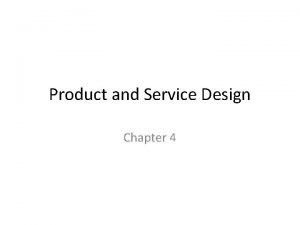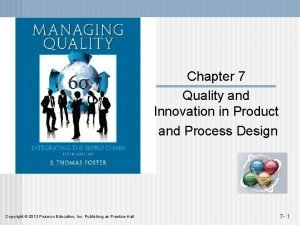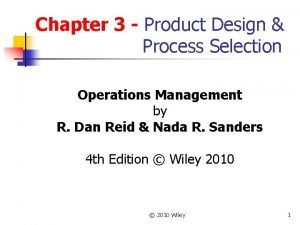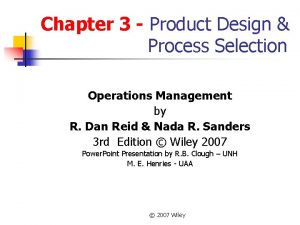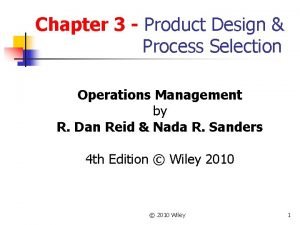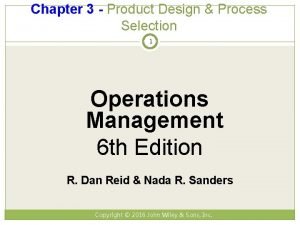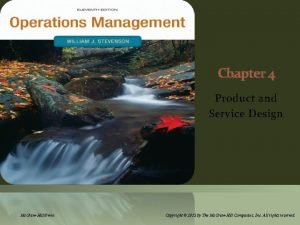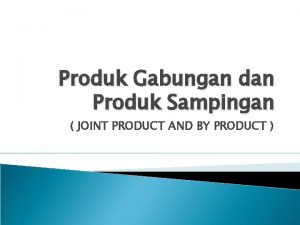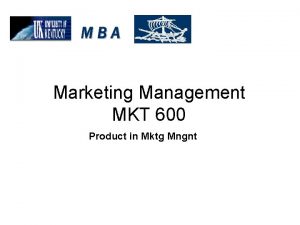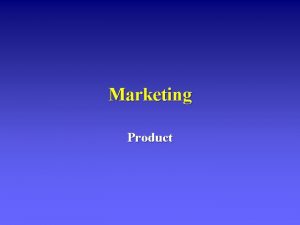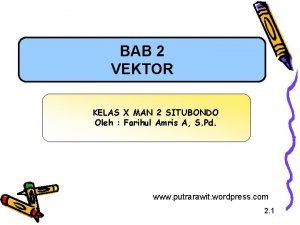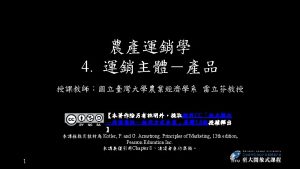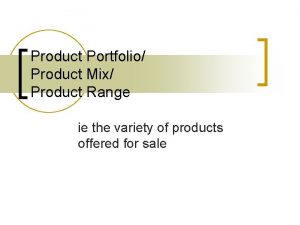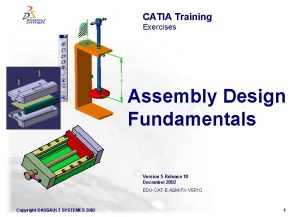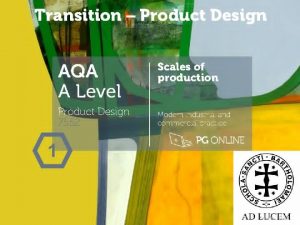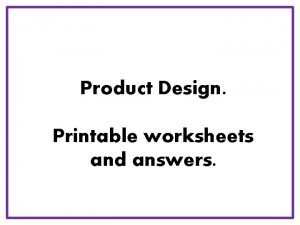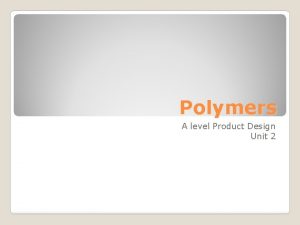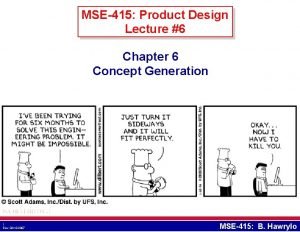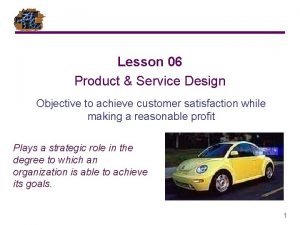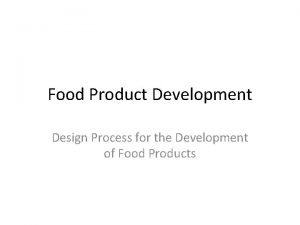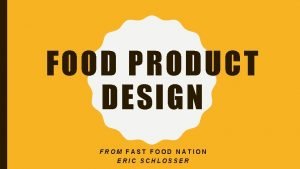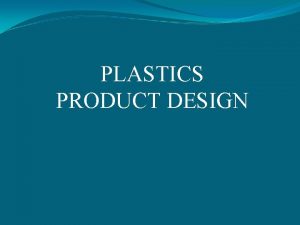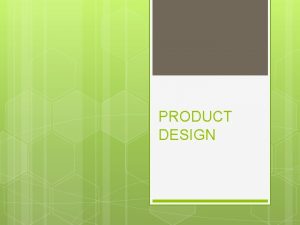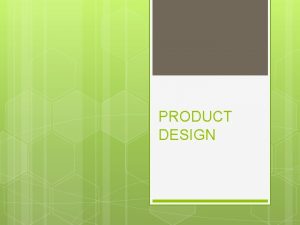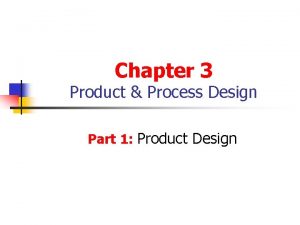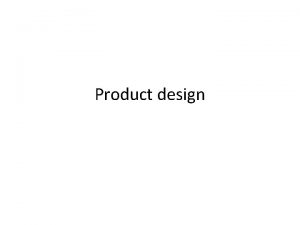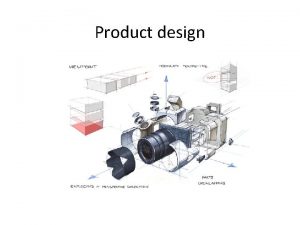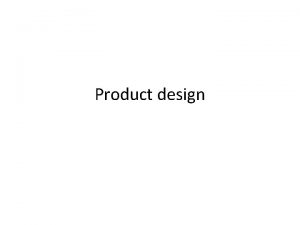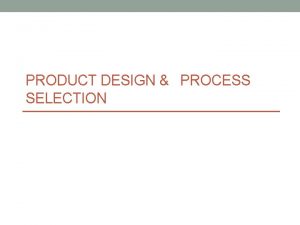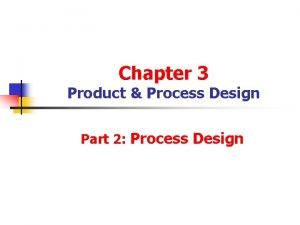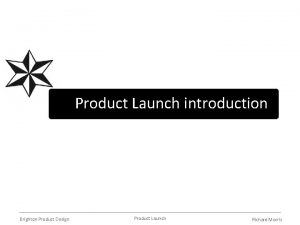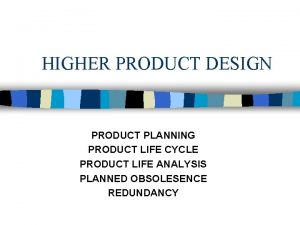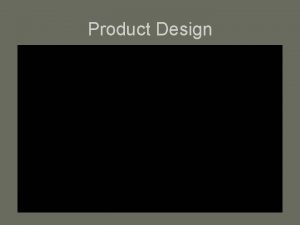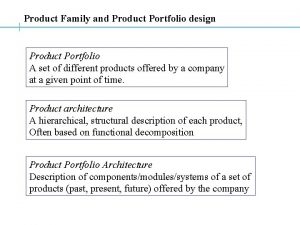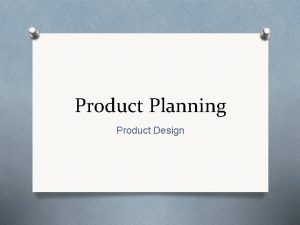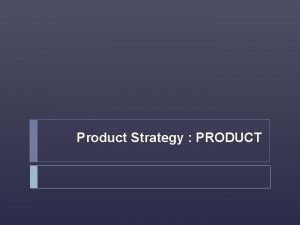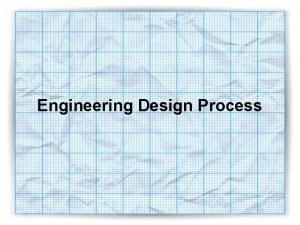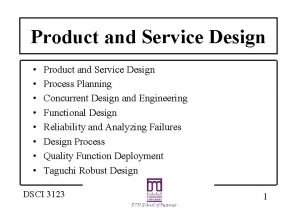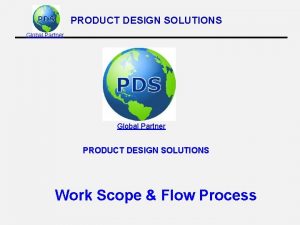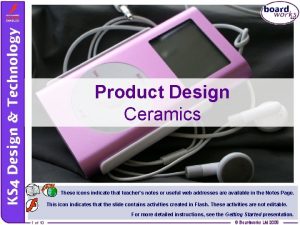Chapter 3 Product Process Design Part 2 Process







































- Slides: 39

Chapter 3 Product & Process Design Part 2: Process Design

Product vs. Process Design n Which comes first: n n n Design of process or Design of product? The answer is ? ?

Product Strategy n Once a company decides to produce a given product or offer a particular service, company should decide if product or service is to be n n n Made-to-order Assemble-to-order (or Built-to-Order) Made-to-stock

Make-to-order n n n Products/services that are made to customer’s specs but only after an order is received. Product/service is customized Volume is ? ? Inventory level is ? ? Delivery time—from time order is place to time it is received--is generally ? ?

Make-to-order n Examples n n n Custom built home or office building Tailor made suit Commercial airplane Wedding cake Professional services (law case, prescriptions, some medical procedures, etc. ) Hair styling

Assemble-to-order (builtto-order) n n n Standard components are produced in anticipation of demand. Once an order is received, components can be combined in different ways to accommodate different customer specs. Some customization May have what type of inventory? Delivery time shorter than make-toorder.

Assemble-to-order (builtto-order) n Examples n n n Computers (Dell) Standard vacation packages Track homes Cars built to customer’s specs Omelet

Make-to-stock n n n Products produced for immediate sale or delivery in anticipation of demand. Product is standardized. Produced in large volumes. May have what type of inventory? Instant or short delivery time.

Make-to-stock n Each unit is produced or assembled by going through same series of operations in same order.

Make-to-stock n Examples n n “Off-the-shelf” items Big ones n n n Cars TV sets Small ones n n Toothpaste Candy

Overview of Product Strategy Bake

Product Strategies n Differ by n n n Degree of customization Type of inventory Delivery time Volume Type of process (later)

Comparison of Product Strategies Make to Order Assemble to Order Make to Stock Very high High Low None WIP Finished goods Delivery time Volume Long Moderate Low Moderate Instant or Very Fast Very high Process Project Batch Customization Type of inventory Line or continuous

Types of Processes n n What type of process is best for each type of product strategy? Processes can be classified as n n Project Batch Line Continuous

Project Process (Custom Job Shop) n n n A process set that makes a one-at-atime product exactly to customer specifications. Product has its own unique processing requirements. Product is routed to different operations (workstations), depending on its own unique needs.

Project Process (Custom Job Shop) n n High degree of customization Low volume

Project Process n n Construction, some medical procedures, landscaping, custom built home, tailor made suit. Therefore, use with products that are “make to order. ”

Batch Process n n Produces small quantities of a product in groups or batches based on customer orders or specs. Product is often made using standard components, which are combined in different ways, depending on product requirements.

Batch Process n n Print shop, computers (Dell), education classes Works best for products that are assemble-to-order.

Example of Layout of a Project or Batch Process: Hospital

Line process (or assembly line) n n n Produces large quantities of a standardized product. Assembly line operation designed for mass production. Each unit is produced or assembled by going through same series of operations performed in same order. Cars, off the shelf items. Works best for make-to-stock products.

Continuous Process n n Very high volumes of a fully standardized product Product is continuous – liquid or gas n n n Oil refinery Water purification plant Liquid chemicals Capital intensive and automated Use for make-to-stock products

Example of Repetitive Process: Car Wash Spray Soap Rinse Dry

Example of Line Process: Hotel Laundry

Classification of Processes Project Batch Intermittent Line Continuou s Repetitive

Processes Characterized by Relationship Between Standardization and Volume

Intermittent vs. Repetitive Processes Decision Intermittent Operation Repetitive Operation Product variety Great Small Degree of standardization Low High Organization of resources Grouped by Function Line flow Path of products Varied, depends on product Line flow Factor driving production Customer orders Forecast of demand Critical resource Labor Capital Type of equipment General purpose Specialized Degree of automation Low High Throughput time Longer Shorter Work-in-process inventory More Less

Types of Processes vs. Product Strategy Types of Process Product Strategy Project Made to order Batch Assemble to order Line Continuous Make to stock

Process Performance Metrics n n To determine if a process is functioning properly, we must measure its performance. To measure performance, process should be in statistical control.

Process Performance Metrics

Process Velocity n n n Should ratio be big or small? What does a ratio of 1. 0 imply? Greater than 1. 0?

Utilization n Should ratio be big or small? What does a ratio of 1. 0 imply? Less than 1. 0?

Efficiency n n Should ratio be big or small? What does a ratio of 1. 0 imply? Less than 1. 0? Greater than 1. 0?

Example – Page 72, text n n A title company is analyzing its operations in an effort to improve performance. The following data has been collected:

n n It takes an average of 4 hrs. to process and close a title. Value added time is estimated at 30 minutes per title. Each title officer is on payroll for 8 hrs. per day, but works 6 hrs. per day on average, accounting for lunches and breaks. Industry standard for labor utilization is 80%.

n n n The company closes 8 titles per day. Industry standard at comparable companies is 10 titles closed per day. Compute n n n Process velocity Labor utilization Efficiency

Process Velocity

Labor Utilization

Efficiency
 Example of product disassembly
Example of product disassembly Design that results in products or services
Design that results in products or services Types of process selection
Types of process selection Quality and innovation in product and process design
Quality and innovation in product and process design Process selection types
Process selection types Process selection operations management
Process selection operations management Product design and process selection
Product design and process selection Process selection in operations management
Process selection in operations management Chapter 4 product and service design ppt
Chapter 4 product and service design ppt Part whole model subtraction
Part whole model subtraction Unit ratio definition
Unit ratio definition Brainpop ratios
Brainpop ratios Technical description
Technical description Layout dispense bar diagram
Layout dispense bar diagram The part of a shadow surrounding the darkest part
The part of a shadow surrounding the darkest part Two way anova minitab 17
Two way anova minitab 17 New product development and product life cycle strategies
New product development and product life cycle strategies Pengertian produk bersama
Pengertian produk bersama Average product of labor
Average product of labor Depth of product line
Depth of product line Core product augmented product
Core product augmented product Dot product vs cross product
Dot product vs cross product Chapter 3 feasibility analysis
Chapter 3 feasibility analysis What is product line depth
What is product line depth Lima buah vektor digambarkan sebagai berikut
Lima buah vektor digambarkan sebagai berikut Core customer value
Core customer value Portfolio range
Portfolio range Perkalian vektor cross dan dot
Perkalian vektor cross dan dot What is gnp and gdp
What is gnp and gdp Process design and control design should always be in
Process design and control design should always be in Catia part design exercise
Catia part design exercise Catia assembly exercises
Catia assembly exercises Aqa product design
Aqa product design Product oriented performance-based assessment
Product oriented performance-based assessment Product design worksheet
Product design worksheet Polymers product design
Polymers product design New concept chapter 6
New concept chapter 6 Product and service design objectives
Product and service design objectives Food product prototype example
Food product prototype example Food product design by eric schlosser
Food product design by eric schlosser

